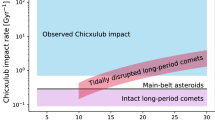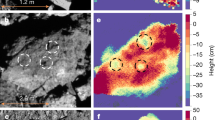Abstract
FOR a week beginning 16 July 1994, fragments of comet Shoemaker-Levy 9 will collide with Jupiter each day. Although the fragments are probably smaller than originally estimated1, the impacts may nevertheless have observable consequences that will provide valuable insight into the properties of comets and the dynamics of planetary atmospheres. Interpretation of these observations will depend sensitively on parameters such as the mass, density and overall structure of the fragments. To deduce some of these parameters, we have simulated the event that created the fragments—the passage of the parent comet through the tidal field of Jupiter in 1992. Modelling the comet as a strengthless aggregate consisting of a large number of grains, we find that the tidally disrupted body condenses rapidly into clumps, driven by their selfgravity. Formation of a fragment chain resembling Shoemaker-Levy 9 occurs for a narrow range of the simulated comet's bulk density, 0.3–0.7 g cm −3. A chain of ∼20 similar-sized fragments matching observations is obtained for a non-rotating parent comet of 1.5 km diameter and bulk density 0.5 g cm−3, suggesting that the clusters will each liberate ∼1027 erg on impact. A slightly larger initial density leads to significant mass variation among the clusters and the possibility of a few ∼1028-erg events.
This is a preview of subscription content, access via your institution
Access options
Subscribe to this journal
Receive 51 print issues and online access
$199.00 per year
only $3.90 per issue
Buy this article
- Purchase on Springer Link
- Instant access to full article PDF
Prices may be subject to local taxes which are calculated during checkout
Similar content being viewed by others
References
Weaver, H. A. et al. Science 263, 787–791 (1994).
Scotti, J. V. & Melosh, H. J. Nature 365, 733–735 (1993).
Boss, A. P. Icarus 107, 422–426 (1994).
Dobrovolskis, A. R. Icarus 88, 24–38 (1990).
Lawn, B. R. & Wilshaw, T. R. Fracture of Brittle Solids (Cambridge Univ. Press, 1975).
Benz, W. & Asphaug, E. Icarus 107, 98–116 (1994).
Peale, S. J. Icarus 82, 36–49 (1989).
Weissman, P. Nature 320, 242–244 (1986).
Melosh, H. J. & Schenk, P. Nature 365, 731–733 (1994).
Weidenschilling, S. J. Nature 368, 721–723 (1994).
Chandrasekhar, S. Hydrodynamic and Hydromagnetic Stability (Oxford Univ. Press, 1961).
Sridhar, S. & Tremaine, S. Icarus 95, 86–99 (1992).
Benner, L. & McKinnon, W. B. Lunar and Planetary Sci. Conf. Abstr. XXV, 93–94 (1994).
Holsapple, K. A. & Housen, K. R. Memorie Soc. astr. ital. 57, 65–85 (1986).
Author information
Authors and Affiliations
Rights and permissions
About this article
Cite this article
Asphaug, E., Benz, W. Density of comet Shoemaker–Levy 9 deduced by modelling breakup of the parent 'rubble pile'. Nature 370, 120–124 (1994). https://doi.org/10.1038/370120a0
Received:
Accepted:
Issue Date:
DOI: https://doi.org/10.1038/370120a0
This article is cited by
-
Shapes, structures, and evolution of small bodies
Astrodynamics (2021)
-
Origin and Evolution of Cometary Nuclei
Space Science Reviews (2020)
-
The Thermal, Mechanical, Structural, and Dielectric Properties of Cometary Nuclei After Rosetta
Space Science Reviews (2019)
-
Structural analysis of rubble-pile asteroids applied to collisional evolution
Astrodynamics (2017)
-
Comet Geology with Deep Impact Remote Sensing
Space Science Reviews (2005)
Comments
By submitting a comment you agree to abide by our Terms and Community Guidelines. If you find something abusive or that does not comply with our terms or guidelines please flag it as inappropriate.



